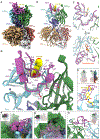Continuous evolution of compact protein degradation tags regulated by selective molecular glues
- PMID: 38484051
- PMCID: PMC11203266
- DOI: 10.1126/science.adk4422
Continuous evolution of compact protein degradation tags regulated by selective molecular glues
Abstract
Conditional protein degradation tags (degrons) are usually >100 amino acids long or are triggered by small molecules with substantial off-target effects, thwarting their use as specific modulators of endogenous protein levels. We developed a phage-assisted continuous evolution platform for molecular glue complexes (MG-PACE) and evolved a 36-amino acid zinc finger (ZF) degron (SD40) that binds the ubiquitin ligase substrate receptor cereblon in complex with PT-179, an orthogonal thalidomide derivative. Endogenous proteins tagged in-frame with SD40 using prime editing are degraded by otherwise inert PT-179. Cryo-electron microscopy structures of SD40 in complex with ligand-bound cereblon revealed mechanistic insights into the molecular basis of SD40's activity and specificity. Our efforts establish a system for continuous evolution of molecular glue complexes and provide ZF tags that overcome shortcomings associated with existing degrons.
Figures





References
-
- Schreiber SL, The Rise of Molecular Glues. Cell 184, 3–9 (2021). - PubMed
-
- Bier D, Thiel P, Briels J, Ottmann C, Stabilization of Protein–Protein Interactions in chemical biology and drug discovery. Prog. Biophys. Mol. Biol 119, 10–19 (2015). - PubMed
-
- Krönke J, Udeshi ND, Narla A, Grauman P, Hurst SN, McConkey M, Svinkina T, Heckl D, Comer E, Li X, Ciarlo C, Hartman E, Munshi N, Schenone M, Schreiber SL, Carr SA, Ebert BL, Lenalidomide Causes Selective Degradation of IKZF1 and IKZF3 in Multiple Myeloma Cells. Science 343, 301–305 (2014). - PMC - PubMed
Publication types
MeSH terms
Substances
Grants and funding
LinkOut - more resources
Full Text Sources
Molecular Biology Databases
Research Materials

